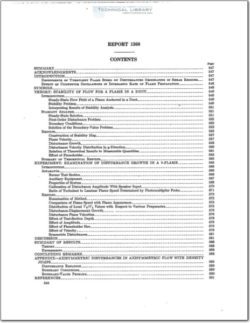NACA-Report-1360

- Version
- 143 Downloads
- 4.44 MB File Size
- 1 File Count
- December 4, 2015 Create Date
- December 4, 2015 Last Updated
National Advisory Committee for Aeronautics, Report - Growth of Disturbances in a Flame Generated Shear Region

The growth of transverse velocity disturbances in the shear
region caused by a flame in a duct was examined theoretically
and experimentally. In the theoretical stability analysis, a
flow field arising from a flame in a duct was analyzed. The
flow was neutrally stable to symmetric disturbances and un-
stable to antisymmetric ones. As a disturbance of given fre—
quency moves downstream from the flameholder, a most-amplified
frequency is found that is equal to flow velocity divided by duct
width. Disturbances at frequencies greater or less than this
are ,less amplified. The amount that an incoming disturbance
is amplified depends on the flame slope. For the most-amplified
frequency, the ratio of terminal to initial transverse disturbance
velocity is equal to (1 .1)””°”‘, where the slope is roughly turbu-
lent flame speed divided by flow velocity. This ratio of terminal
to initial transverse disturbance velocity depends on inlet velocity
and flame speed only in the stated manner and is essentially in—
dependent of density ratio.
The critical wavelength separating disturbances that grow
from those that do not grow varies as a constant times flame
width. The constant is 2% for flames that are narrow compared
with duct width and becomes infinite as the flame reaches the
wall. The flow is unstable to disturbances having wavelengths
greater than critical. Thus, short-wavelength (i. e., high—
frequency) disturbances achieve their terminal amplifications
near the flameh older, while long-wavelength disturbances achieve
theirs farther downstream. The most-amplified disturbance
achieves its terminal amplification when the flame fills 0.60 of
the duct. The results are related to measurable quantities in
the form of (I) flame—front displacement, (2) phase velocity, and
(3) to a first approximation, the effect of disturbance frequency
on flame-propagation velocity.
In the experimental part of the program disturbances of
various frequencies were imposed on a flame stabilized in a
duct, and the ejects were measured by shadow photography and
photomultiplier-probe surveys. Eforts to verify elements of
the theory are encouraging but not conclusive. Reasonable
agreement is achieved in the comparison of flame-front displace-
ment and phase velocity. In the measurements of the efiect of
frequency of disturbance on flame speed, there appeared to be
a most—efective frequency, which was twice the most amplified
frequency given by theory. There is no direct evidence of
transition due to the amplified disturbances.
| File | Action |
|---|---|
| naca-report-1360.pdf | Download |

Comment On This Post